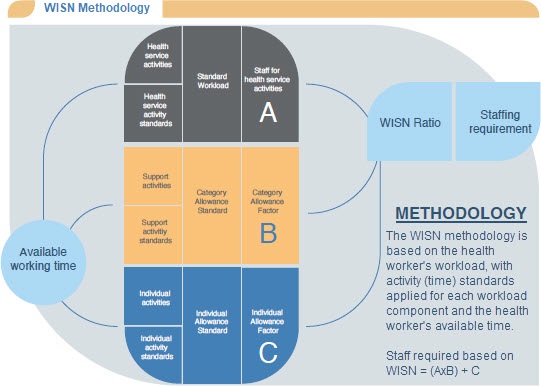Workload Indicators of staffing need (WISN)
The health workforce is the fulcrum on which health system performance relies. Human resources for health as a strategic area of focus is crucial to affordable, accessible and high-quality health services. The ability of a country to meet its health commitments and goals largely depends on the number, skills, competencies and availability of health workers, and on whether those workers are organized and equitably distributed to deliver integrated, people-centred health services. The health workforce is essential to achieving universal health coverage and the Sustainable Development Goals, especially Indicator 3.c.1, which relates to ”health workforce density and distribution” and improved data on human resources for health.
Health service managers around the world face increasing HRH challenges, such as:
- inadequate resources to respond to the populations’ demand for services;
- the distribution of human resources being generally poorly balanced between urban and rural areas, and between primary, secondary and tertiary levels of care;
- inefficiencies due to uncoordinated HRH practices from various stakeholders; and
- weak HRH coordination mechanisms and weak human resources for health information systems.
The Workload Indicators of Staffing Need (WISN) method is based on a health worker’s workload, with activity (time) standards applied for each workload component. This principle has long been used in business but was not employed in the health sector until the late 1990s, when the WISN method was field tested and used in several countries.
NEW WISN Manual

Workload Indicators of Staffing Need (WISN) User Manual, 2nd edition
Access the WISN Tool
Please visit the community of practice (self-registration) to access the software tool.
WISN implementation groups and their roles

Workload Indicators of Staffing Need (WISN) process infographic
WISN methodology infographic

Workload Indicators of Staffing Need (WISN) methodology infographic
Publications

Workload Indicators of Staffing Need (WISN) User Manual, 2nd edition
The health workforce is the fulcrum on which health system performance relies. Human resources for health (HRH) is crucial to affordable, accessible and...

Applying the WISN method in practice: case studies from Indonesia, Mozambique and Uganda
This document, which complements the revised Workload indicators of staffing need (WISN): user’s manual, provides examples of how the WISN method...

Workload indicators of staffing need (WISN): selected country implementation experiences
Since the launch of the computerised version of the Workload Indicators of Staffing Need (WISN) tool in 2010, many countries have implemented WISN studies...
Countries' experiences on implementing WISN methodology for health workforce planning and estimation
Publication of this Human Resources for Health journal supplement was supported by the World Health Organization (WHO). Articles have undergone the journal's standard peer review process for supplements.

Global experiences in health workforce policy, planning and management using the Workload Indicators...
Countries that have been planning for health workforce using simple population ratios and health worker density benchmarks, realize that these traditional...

Assessing the staffing needs for primary health care centers in Cross River State, Nigeria: a workload...
A major human resources for health challenge for Nigeria is ensuring the availability and retention of adequate competent health workers in the right mix...

Workload assessment of medical doctors at primary health care centers in the Duhok governorate
A shortage in human resources, particularly physicians, has become a challenge confronting health authorities in the Duhok governorate, as these resources...

Determining staffing standards for primary care services using workload indicators of staffing needs...
Health services cannot be delivered without an adequate, competent health workforce. Evidence suggests a direct relationship between density of health...
- 1 (current)
- 2
- 3
- 4
- 5
